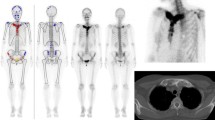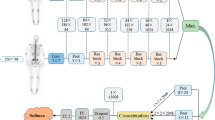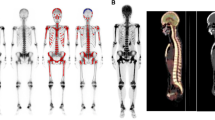Abstract
Objective
The accuracy of bone scintigraphy analyzed by computer-assisted diagnosis (CAD) software involving multiple artificial neural network (ANN) systems has not been well established.
Methods
We conducted a retrospective study to examine the accuracy of bone scintigraphy analyzed by CAD software, BONENAVI® version 2 (BN2; FUJIFILM RI Pharma Co., Ltd.), in patients with suspected bone metastases. In 399 patients, bone metastases were analyzed by means of the BN2 focused on balance of sensitivity and specificity ANN system (BN2-B), focused on specificity-ANN system (BN2-Sp), and focused on sensitivity-ANN system (BN2-Sen). The ANN presented an output between 0 and 1 for each patient. A cutoff value of 0.5 was chosen to provide BN2 with the binary classification of “bone metastasis” or “no bone metastasis”. The area under the receiver operating characteristic curve (AUC) was used to evaluate diagnostic accuracy.
Results
A total of 18 % of male patients (36/196) and 12 % of female patients (24/203) had bone metastases. BN2-Sp and BN2-Sen were similar to BN2-B in the ability to identify patients who had bone metastases; the AUC values were 0.87 [95 % confidence interval (CI) 0.79–0.95], 0.92 (95 % CI 0.85–0.97), and 0.90 (95 % CI 0.83–0.97), respectively, in male patients. In female patients, the AUC values were 0.81 (95 % CI 0.71–0.91), 0.85 (95 % CI 0.78–0.93), and 0.81 (95 % CI 0.71–0.92), respectively. A total of 65.4 % of patients were classified as concordance of “bone metastases” (17.8 %) or “no bone metastases” (47.6 %), and 34.6 % were classified as mismatch. In the concordance group, BN2-B revealed an AUC of 0.94 (95 % CI 0.88–0.99), with a sensitivity of 94 % (95 % CI 79–98 %) and a specificity of 88 % (95 % CI 79–93 %) in 120 male patients and an AUC of 0.89 (95 % CI 0.78–1.00), with a sensitivity of 86 % (95 % CI 60–96 %) and a specificity of 85 % (95 % CI 78–90 %) in 141 female patients.
Conclusions
Bone scintigraphy analyzed by BN2-B accurately identifies the presence of bone metastases in patients with concordance using three ANN systems, comprising 65 % of the patients we studied.



Similar content being viewed by others
References
Yang L, Fujimoto J, Qiu D, Sakamoto N. Trends in cancer mortality in the elderly in Japan, 1970–2007. Ann Oncol. 2010;21:389–96.
Coleman RE. Clinical features of metastatic bone disease and risk of skeletal morbidity. Clin Cancer Res. 2006;12:6243s–9s.
Koizumi M, Yoshimoto M, Kasumi F, Ogata E. Comparison between solitary and multiple skeletal metastatic lesions of breast cancer patients. Ann Oncol. 2003;14:1234–40.
Sabbatini P, Larson SM, Kremer A, Zhang ZF, Sun M, Yeung H, et al. Prognostic significance of extent of disease in bone in patients with androgen-independent prostate cancer. J Clin Oncol. 1999;17:948–57.
Soloway MS, Hardeman SW, Hickey D, Raymond J, Todd B, Soloway S, et al. Stratification of patients with metastatic prostate cancer based on extent of disease on initial bone scan. Cancer. 1988;61:195–202.
Imbriaco M, Larson SM, Yeung HW, Mawlawi OR, Erdi Y, Venkatraman ES, et al. A new parameter for measuring metastatic bone involvement by prostate cancer: the bone scan index. Clin Cancer Res. 1998;4:1765–72.
Erdi YE, Humm JL, Imbriaco M, Yeung H, Larson SM. Quantitative bone metastases analysis based on image segmentation. J Nucl Med. 1997;38:1401–6.
Sadik M, Hamadeh I, Nordblom P, Suurkula M, Hoglund P, Ohlsson M, et al. Computer-assisted interpretation of planar whole-body bone scans. J Nucl Med. 2008;49:1958–65.
Dennis ER, Jia X, Mezheritskiy IS, Stephenson RD, Schoder H, Fox JJ, et al. Bone scan index: a quantitative treatment response biomarker for castration-resistant metastatic prostate cancer. J Clin Oncol. 2012;30:519–24.
Ulmert D, Kaboteh R, Fox JJ, Savage C, Evans MJ, Lilja H, et al. A novel automated platform for quantifying the extent of skeletal tumour involvement in prostate cancer patients using the bone scan index. Eur Urol. 2012;62:78–84.
Kikuchi A, Onoguchi M, Horikoshi H, Sjostrand K, Edenbrandt L. Automated segmentation of the skeleton in whole-body bone scans: influence of difference in atlas. Nucl Med Commun. 2012;33:947–53.
Horikoshi H, Kikuchi A, Onoguchi M, Sjostrand K, Edenbrandt L. Computer-aided diagnosis system for bone scintigrams from Japanese patients: importance of training database. Ann Nucl Med. 2012;26:622–6.
Takahashi Y, Yoshimura M, Suzuki K, Hashimoto T, Hirose H, Uchida K, et al. Assessment of bone scans in advanced prostate carcinoma using fully automated and semi-automated bone scan index methods. Ann Nucl Med. 2012;26:586–93.
Wakabayashi H, Nakajima K, Mizokami A, Namiki M, Inaki A, Taki J, et al. Bone scintigraphy as a new imaging biomarker: the relationship between bone scan index and bone metabolic markers in prostate cancer patients with bone metastases. Ann Nucl Med. 2013;27:802–7.
Mitsui Y, Shiina H, Yamamoto Y, Haramoto M, Arichi N, Yasumoto H, et al. Prediction of survival benefit using an automated bone scan index in patients with castration-resistant prostate cancer. BJU Int. 2012;110:E628–34.
Nakajima K, Nakajima Y, Horikoshi H, Ueno M, Wakabayashi H, Shiga T, et al. Enhanced diagnostic accuracy for quantitative bone scan using an artificial neural network system: a Japanese multi-center database project. EJNMMI Res. 2013;. doi:10.1186/2191-219X-3-83.
Hamaoka T, Madewell JE, Podoloff DA, Hortobagyi GN, Ueno NT. Bone imaging in metastatic breast cancer. J Clin Oncol. 2004;22:2942–53.
DeLong ER, DeLong DM, Clarke-Pearson DL. Comparing the areas under two or more correlated receiver operating characteristic curves: a nonparametric approach. Biometrics. 1988;44:837–45.
Wilson EB. Probable inference, the law of succession, and statistical inference. J Am Stat Assoc. 1927;22:209–12.
McNemar Q. Note on the sampling error of the difference between correlated proportions or percentages. Psychometrika. 1947;12:153–7.
Valenstein PN. Evaluating diagnostic tests with imperfect standards. Am J Clin Pathol. 1990;93:252–8.
Dähnert W. Radiology Review Manual. 7th ed. Philadelphia: Lippincott Williams & Wilkins; 2011.
Acknowledgments
We are indebted to the Department of International Medical Communications of Tokyo Medical University for the editorial review of the English manuscript. Furthermore, we appreciate the advice regarding statistical analysis from Keizo Takatoku at FUJIFILM RI Pharma Co., Ltd., Japan.
Conflict of interest
None declared.
Author information
Authors and Affiliations
Corresponding author
Rights and permissions
About this article
Cite this article
Kikushima, S., Hanawa, N. & Kotake, F. Diagnostic performance of bone scintigraphy analyzed by three artificial neural network systems. Ann Nucl Med 29, 125–131 (2015). https://doi.org/10.1007/s12149-014-0919-5
Received:
Accepted:
Published:
Issue Date:
DOI: https://doi.org/10.1007/s12149-014-0919-5




